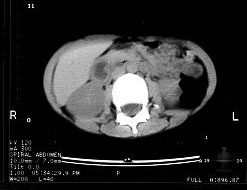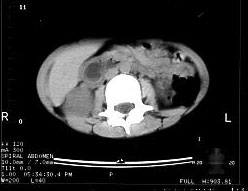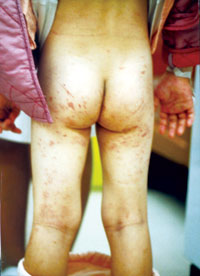
|
September 2002, Volume 24, No. 9
|
Case Report
|
|||||||
Examination of the lower limbs in children with abdominal pain (Henoch-Schonlein Purpura)Y W Cheng 鄭恩華, K T So 蘇鈞堂 HK Pract 2002;24:450-454 Summary Abdominal pain is a common presenting symptom in children with Henoch-Schonlein Purpura (HSP) and HSP should be considered in every child presenting with abdominal pain. Early and prompt diagnosis of HSP by finding of typical skin rashes over the lower limbs will save children from unnecessary investigations and invasive procedures such as joint tapping and laparotomy. Unnecessary use of antibiotic may also be avoided. A short course of steroid causes dramatic improvement of the gastrointestinal symptoms and may also prevent further ischaemia of the bowel. 摘要 腹痛是過敏性紫癜(HSP)病童常見的病徵。每 個腹痛的兒童都應考慮HSP。下肢典型皮疹可以幫助醫生及早診斷此病,減少兒童不必要的檢查和創傷性治療,如關節穿刺和剖腹手術。應避免不必要使用抗生素。短期類固醇療法可有效改善胃腸道病徵和防止腸臟進一步缺氧。 Introduction Henoch-Schonlein Purpura (HSP) is a well-recognised childhood disease involving the skin, joints, abdomen and the kidneys. The findings of typical rashes i.e. small erythematous maculopapular purpuric rashes on the lower extremities and buttocks make the diagnosis of HSP highly suggestive although not pathognomonic.1 Skin rash is unlikely to be the presenting symptom because it is usually asymptomatic. Instead, gastrointestinal symptoms commonly present probably because of their distressing nature, and occur in about two thirds of patients with HSP.2 Most physicians require gastrointestinal symptoms such as abdominal pain, tarry stool or haematemesis when they diagnose HSP. However, most physicians will forget that HSP is one of the important differential diagnoses in children presenting with abdominal pain. Our two cases illustrate the importance of examining the lower limbs to look for typical skin rashes in patients presenting with abdominal pain to enable early diagnosis of Henoch-Schonlein Purpura. Case one A seven year-old boy with a known history of hypertrophic obstructive cardiomyopathy (HCOM) and secundum atrial septal defect (ASD) was referred by his general practitioner because of diffuse abdominal pain and repeated vomiting. The presumptive diagnosis of gastroenteritis had been made and one dose of intramuscular Rocephin had been given. His abdominal pain was described as diffuse, constant, dull, non-radiating, and unrelated to feeding. Vomiting had begun two days before admission, with maximum of six times non-bloody, non-bilious emeses one day before admission.
Initial examination revealed a lethargic child with mild dehydration and occasionally
writhing in pain: respiratory rate of 30/min; temperature: 36.8
The diagnostic possibility of HSP was high in view of the skin rashes on the buttocks. The surgeon agreed to adopt a wait and see approach rather than to perform a laparotomy to find the cause of bowel ischaemia, and resect the infarcted bowel if present. The child was rehydrated with intravenous fluid and a nasogastric tube was placed for abdominal decompression. The child was kept nil by mouth. Intravenous hydrocortisone resulted in rapid and complete relief of abdominal pain within minutes. The quick response to hydrocortisone further supported the diagnosis of HSP.3 The abdomen was examined more easily once voluntary guarding was eliminated after steroid treatment. There was no sign of peritonitis on regular abdominal examinations. The diagnosis of HSP became straightforward when full-blown purpuric rashes appeared over the buttocks and lower limbs the next morning. Case 2
A girl aged 6 years presented with a three-day history of abdominal pain, diarrhoea and bilateral knee pain. She had fallen from her bicycle 10 days before admission but there was no injury noticed at that time. The child complained of mild, central, colicky, abdominal pain initially and had passed 2-3 loose stools per day, without blood or mucus, for three days. The child was admitted to the orthropaedics unit for further investigation of the knee pain. Examination revealed a febrile child. The child refused to walk because of bilateral knee pain. The abdomen was soft and there was tenderness over the epigastrium. There were no masses nor signs of peritonitis. There was swelling and warmness over both knees. The right knee was tapped under aseptic technique but failed to find fluid. Antibiotics were started in view of the possibility of septic arthritis. A paediatrician was consulted for fever and increasing severity of abdominal pain. On further examination, there was a typical maculopapular rash over the buttocks and lower limbs (Figure 2). This typical skin rash was a sine qua non for the diagnosis of HSP. Investigations showed normal white cell count, normal amylase level and normal ultrasonography of the abdomen. The child was supported with intravenous fluid. The abdominal pain responded promptly to intravenous hydrocortisone. The joint pain and swelling also responded to the steroid and oral non-steroidal anti-inflammatory drug, naproxen 125 mg twice daily for three days. Antibiotics were stopped when HSP was diagnosed. The patient was discharged on day 3 of admission without recurrence of the abdominal symptoms. The child is currently an outpatient under observation for the persistent microscopic haematuria, a complication of HSP. Further investigation findings in our patient included positive guaiac-positive stools, microscopic haematuria and raised IgA level (2.93g/L). All these results supported the diagnosis of HSP with involvement of the gastrointestinal and renal systems. Discussion Henoch-Schonlein Purpura In 1837, Johann Schonlein described the association of arthralgia and purpura and described it as "peliosis rheumatica". His former student Eduard Henoch then described the consequences of gastrointestinal involvement of four patients in 1874 and he further described renal involvement in this illness. The disease was named as Henoch-Schonlein Purpura after their contributions. Diagnosis The American College of Rheumatology 1990 criteria for the classification of Henoch-Schonlein Purpura required non-thrombocytopenic purpura and one or more of the following: arthritis, abdominal pain, gastrointestinal bleeding or nephritis.4 Therefore these two children presenting with abdominal pain and skin rashes with normal platelet count had already fulfilled the diagnosis of HSP. Pathogenesis Nowadays, Henoch-Schonlein Purpura is a well-known childhood disease as a consequence of systemic leukocytoclastic vasculitis. The etiology of HSP remains unknown, but it is clear that IgA plays a critical role in the immunopathogenesis, as evidenced by increased serum IgA concentrations, IgA-containing circulating immune complexes, and IgA deposition in vessel walls and renal mesangium.5-7 Gastrointestinal manifestations in HSP Gastrointestinal manifestations are common symptoms in patient with HSP; including abdominal pain in 50%-75% of subjects, melena or guaiac-positive stools in 50%, haematemesis in 30%, massive haemorrhage in 2%, and intussusception in 2%.8-10 Other less common manifestations have been reported including acute appendicitis,11 functional bowel obstruction/paralytic ileus,12 bowel ischaemia, infarction, necrosis,13 spontaneous perforation of small bowel,14 entero-enteral fistulae,15 steatorrhoea,16 acute pancreatitis,17 gall bladder involvement17 and late ileal strictures.18 Severe ischaemic involvement of the small bowel in HSP can lead to full thickness bowel infarction necessitating resection. It is believed that the ischaemia is due to vasculitis -- induced thrombosis. Consequent ischaemia may be of sufficient severity to cause full thickness necrosis of the bowel wall, and ultimately perforation.13,14 Corticosteroids in treatment of gastrointestinal disease The molecular mechanism of corticosteroid in the anti-inflammatory and immunosuppressive activity has been elucidated in some studies.20,21 There have been no double-blind, placebo-controlled trial of the effect of steroid and the optimal dosage of steroid in treating HSP. Some studies have used oral prednisone 2mg/kg/day which suggested more rapid improvement in the abdominal pain in the corticosteroid treated group, but showed no significant difference in results after 72 hours of treatment.22 Lin et al. recently reported that oral corticosteroid given upon the appearance of the rash would alleviate abdominal pain in an average of 2.4 days.23 A retrospective review suggested that early steroid would decrease the incidence of intussusception: there was a 4% incidence of intussusception in HSP patients not treated with prednisone compared with 0% in treated subjects.24 However, there has been no prospective study to show that early diagnosis or early institution of steroid resulted in fewer gastrointestinal complications. Case discussion In the first case, the detection of rashes over the lower limbs rescued the child from a major operation. Laparotomy for finding the causes of ischaemic bowel such as mal-rotation and Ladd's band were avoided in our patient. Early use of intravenous steroid may have prevented the progress to full thickness infarction of the bowel. In the second case, it is obvious that the child may have avoided the invasive joint tapping, painful intramuscular injection and unnecessary antibiotic administration if the diagnosis of HSP had been made earlier. In both cases, the child responded dramatically to intravenous corticosteroid, which further supported the diagnosis of HSP. Although abdominal symptoms may precede the typical purpura rash in HSP in 14-36%,24,25 it is suggested that the subtle and initial phase of the skin rash over the lower limbs may be overlooked. It is reasonable to believe that appearance of the skin rash is a gradual process rather than an all-or-nothing phenomenon. A few purpuric rashes, particularly over the buttocks may be overlooked or the importance of these few spots may be underestimated. In our experience, a high index of suspicion and a quick look at the lower limbs for skin rashes is important in making an early diagnosis of HSP in children presenting with abdominal pain. Some cases of Henoch-Schonlein Purpura were discovered on admission with this careful approach. The few seconds taken to examine the lower limbs might save the child from undergoing a long list of investigations. Conclusion Purpuric rash over the lower limbs is a sentinel and nearly diagnostic finding in Henoch-Schonlein Purpura. Absence of skin manifestations in conjunction with severe gastrointestinal symptoms is unusual.24-26 Careful examination of the lower limbs for subtle purpuric skin lesions in children presenting with abdominal pain may change the management of the patient. Repeated examination of the lower limbs may be needed in some of the patients in whom the abdominal pain precedes the typical rash. Unnecessary investigations and invasive procedures such as joint tapping, laparotomy and unnecessary use of antibiotic may also be avoided if early diagnosis of HSP can be made. Treatment with steroid results in rapid improvement of the severe abdominal pain.27 Moreover, it may arrest the progression of bowel vasculitis to full bowel thickness infarction and perforation, which carry a high degree of mortality.
Y W Cheng, MBChB(CUHK), DCH(Ireland & International), MRCP(UK) Chief of Service, Department of Paediatrics and Adolescent Medicine, Tuen Mun Hospital. Correspondence to: Dr Y W Cheng,Department of Paediatrics and Adolescent Medicine, Tuen Mun Hospital, Tuen Mun, N.T., Hong Kong. References
|
||||||||


